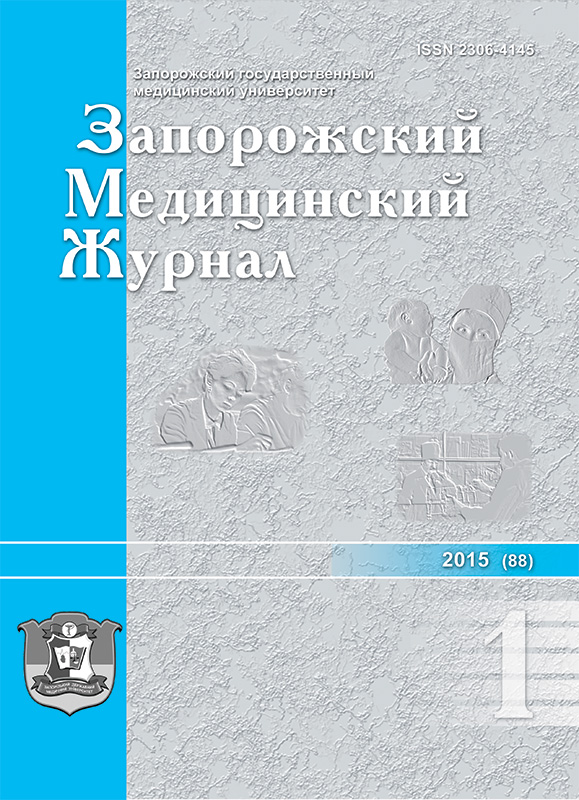Correlation of melatonin and TNF-α levels with characteristics of sleep in patients with rheumatoid arthritis
DOI:
https://doi.org/10.14739/2310-1210.2015.1.39213Keywords:
Melatonin, Tumor Necrosis Factor-alpha, Sleep Disorders, Rheumatoid ArthritisAbstract
Specific immune and neuroendocrine factors are considered in the pathogenic mechanisms of sleep disorders in RA.
The aim was to investigate the nature of the correlation between sleep disorders and levels of serum melatonin and TNF-α in RA patients.
Methods and results. 105 patients and 30 healthy control subjects were examined in the study.
Investigation of sleep disorders was conducted by semi-structured clinical interview using the Insomnia severity index (ISI) and with the visual analogue scale (VAS) of sleep disorders. It was found significant differences in the metabolism of melatonin and TNF-α in healthy and RA patients with different variants of insomnia (p <0.01). Differences between the levels of TNF-α and all variants of insomnia (p <0.05) were identified.
Conclusion. The lack of a direct relations between melatonin and insomnia in patients with RA indicates complex multifactorial nature of sleep disorders in this pathology.
References
Sikalo, Yu. K., & Stanislavchuk, M. A. (2013) Osoblyvosti melatoninovoho ta tsytokinovoho profiliu u khvorykh na revmatoidnyi artryt [Сharacteriscics of melatonin and cytokine profile in patients with rheumatoid arthritis]. Ukrainskyi revmatolohichnyi zhurnal, 4(54), 111–115. [in Ukrainian].
Sikalo, Yu. K., & Stanislavchuk, M. A. (2014) Osoblyvosti psykhichnoho stanu khvorykh na revmatoidnyi artryt: zv’iazok z rivnem melatoninu ta pokaznykamy faktora nekrozu pukhlyny alfa krovi [Disturbance of psychical status in patients with RA: connection with melatonin and TNF-α levels]. Liky Ukrainy Plius, 1(18), 52–55. Retrieved from http://www.health-medix.com/articles/liki_ukr_plus/2014-02-12/kl_7.pdf. [in Ukrainian].
Sikalo, Yu. K., Stanislavchuk, N. A. (2014) Sleep disturbances in rheumatoid arthritis and current approaches to their treatment. Bol'. Sustavy. Pozvonochnik, 3(15), 66–69. [in Ukrainian].
Dowlati, Y., Herrmann, N., Swardfager, W., Liu, H., Sham, L., Reim, E. K., & Lanctôt, K. L. (2010) A meta-analysis of cytokines in major depression. Biol Psychiatry, 67(5), 446–57. doi: 10.1016/j.biopsych.2009.09.033.
Abad, V. C., Sarinas, P., & Guilleminault, C. (2008) Sleep and rheumatologic disorders. Sleep Med. Rev., 12(211), 28. doi: 10.1016/j.smrv.2007.09.001.
Bastien, C. H., Vallières, A., & Morin, C. M. (2001) Validation of the Insomnia Severity Index as an outcome measure for insomnia research. Sleep Med., 2(4), 297–307.
Sikalo, J. K., & Stanislavchuk, M. A. (2014) Sleep disturbances in rheumatoid arthritis: relationship with the disease severity and psycho-emotional status. Acta Reumatolόgica Portuguesa, 39(3), 35–36.
Jan, J. E., Reiter, R. J., Wasdell, M. B., & Bax, M. (2009) The role of the thalamus in sleep, pineal melatonin production, and circadian rhythm sleep disorders. J Pineal Res., 46 (1), 1–7. doi: 10.1111/j.1600-079X.2008.00628.x.
Wolfe, F., Michaud, K., & Li, T. (2006) Sleep disturbance in patients with rheumatoid arthritis: evaluation by medical outcomes study and visual analog sleep scale. J. Rheumatol., 33(1942), 51.
Downloads
How to Cite
Issue
Section
License
Authors who publish with this journal agree to the following terms:
Authors retain copyright and grant the journal right of first publication with the work simultaneously licensed under a Creative Commons Attribution License that allows others to share the work with an acknowledgement of the work's authorship and initial publication in this journal. 
Authors are able to enter into separate, additional contractual arrangements for the non-exclusive distribution of the journal's published version of the work (e.g., post it to an institutional repository or publish it in a book), with an acknowledgement of its initial publication in this journal.
Authors are permitted and encouraged to post their work online (e.g., in institutional repositories or on their website) prior to and during the submission process, as it can lead to productive exchanges, as well as earlier and greater citation of published work (See The Effect of Open Access)

